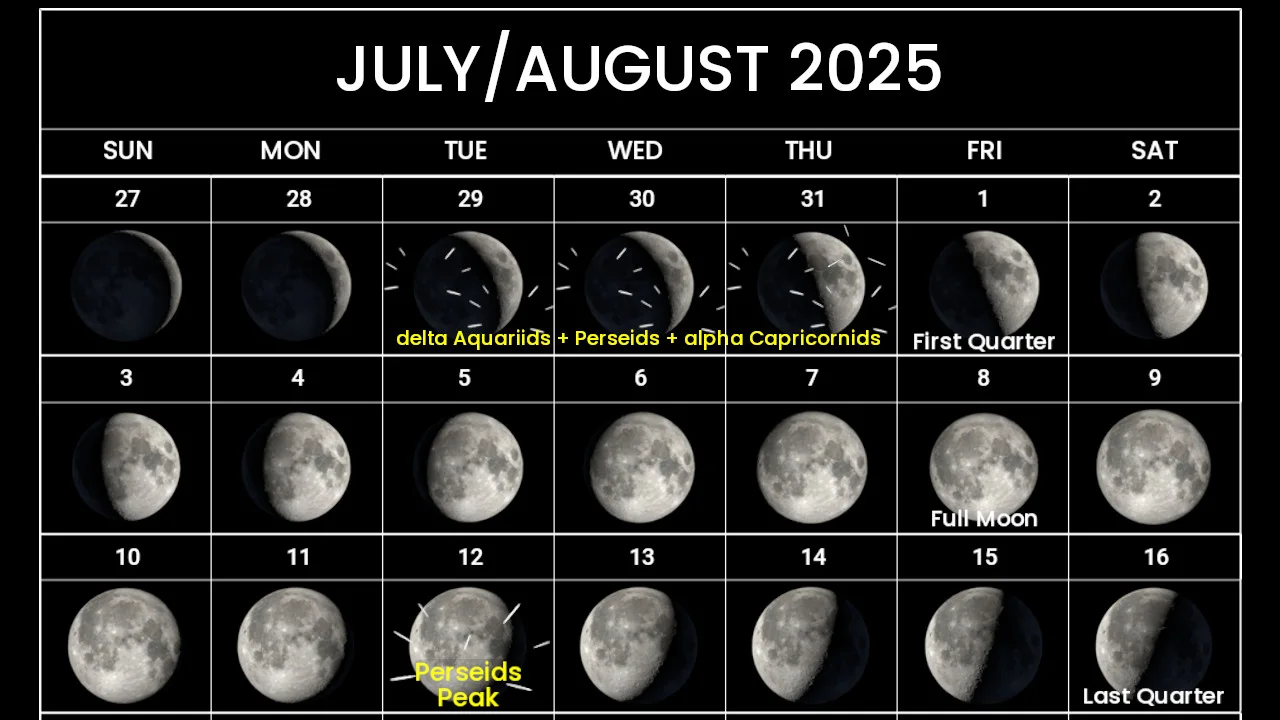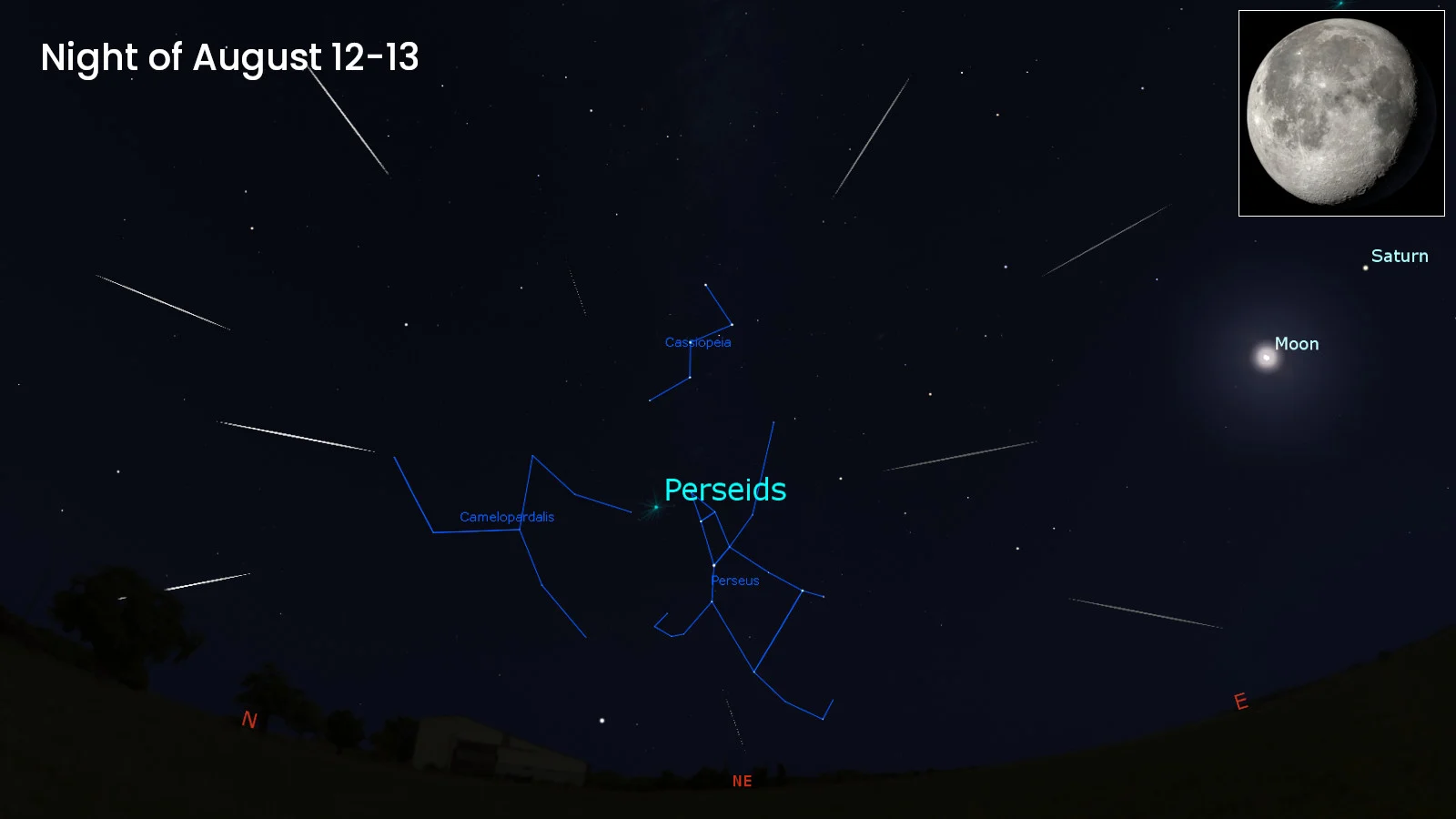
Look up! Perseids and a Planet Parade shine in August 2025
Watch for fireballs, plus a string of planets arrayed across the predawn sky.
Eyes to the sky for August's Sturgeon Moon, a continuing trio of meteor showers, a conjunction of the two brightest planets in the sky, and a predawn 'planet parade'.
Here is the Astronomical Guide for August 2025:
August 1 — First Quarter Moon
August 8-9 — Full Sturgeon Moon
August 10 — Mercury becomes visible just before sunrise, beginning the 'planet parade'
August 11 & 12 — Saturn near the Gibbous Moon
August 12 — Jupiter and Venus very close together (predawn)
August 12 — Saturn near the Waning Gibbous Moon (overnight)
August 12-13 — Perseid Meteor Shower peaks (overnight)
August 16 — Last Quarter Moon
August 19 & 20 — Waning Crescent Moon passes Jupiter and Venus (predawn)
August 21 — Waning Crescent Moon near Mercury (predawn)
August 23 — New Moon (Black Moon)
August 26 — Mars near the Waxing Crescent Moon (after sunset)
August 31 — First Quarter Moon
The Moon

The astronomical events for August 2025, including the phases of the Moon, planetary conjunctions, and meteor showers. (Scott Sutherland, moon graphics from NASA's Scientific Visualization Studio, conjunctions courtesy Stellarium)
The First Quarter Moon occurs on the very first morning of the month, followed by the Waxing Gibbous Moon each night from the 2nd through the 7th.
The Full Sturgeon Moon will rise on the night of the 8th, although it will not officially reach "Full" until nearly 4 a.m. EDT. However, the Moon will appear full (over 99 per cent illuminated by the Sun) from the morning of the 8th through the morning of the 10th.
The Waning Gibbous Moon will shine from the 9th through the 15th, with the Last Quarter Moon on the 16th. Afterwards, from the 17th to the 22nd, the Waning Crescent Moon will be hanging out in the eastern sky before sunrise, getting closer and closer to the horizon each morning, until we have the New Moon on the 23rd.
This particular New Moon is a special "Black Moon". Just like we have a Blue Moon during the third Full Moon in a season with four Full Moons, a Black Moon occurs as the third New Moon in a season with four New Moons. The last time this occurred was in May 2023, and the next 'seasonal' Black Moon will happen in August 2028.
The Waxing Crescent Moon returns to our evening skies from the 24th through the 30th, with the First Quarter Moon right at the end of the month.
DON'T MISS: Watch bright meteors flash across the Milky Way this summer
Meteor showers
Continuing their appearance in our night skies from the end of July, the Perseid, delta Aquariid, and alpha Capricornid meteor showers will still be sending streaks of light crossing overhead for at least the first two weeks of August.
The delta Aquariids and alpha Capricornids, having peaked at the end of July, will both be ramping down their numbers during this time. Meanwhile, the Perseids will be building up to their peak on the night of the 12th to 13th.
Unfortunately, the Moon will hamper our efforts to get the most out of these meteor showers, as its brightest phases will be shining in the sky throughout the first half of August.

The phases of the Moon for the last week of July and the first half of August are shown here, along with the peaks of the delta Aquariid, alpha Capricornid, and Perseid meteor showers. (Scott Sutherland/NASA's Scientific Visualization Studio)
Especially on humid August nights, the 'extra' light will wash out the sky, making it more difficult to spot the brief flashes from meteors.
Fortunately, the Perseids are well known for the bright fireballs produced during the shower. At least as bright as the planet Venus, fireballs can be seen far and wide, even piercing through urban or lunar light pollution.

The radiant of the Perseid meteor shower, in the northeast sky, on the night of August 12-13, 2025. The phase of the Moon — Waning Gibbous — is shown (inset) in the top right corner. (Stellarium/NASA's NASA's Scientific Visualization Studio/Scott Sutherland)
READ MORE: How to get the most out of meteor showers and other night sky events
A new Planet Parade
Each evening throughout the month of August, we can see the planet Mars in the western sky after sunset. To find it, look for the brightest star you can find in that region of the sky. That should be the binary star, Spica, in the constellation Virgo. Just to the right of that, the red unblinking 'star' should be Mars.
There's quite a show going on in the predawn skies throughout much of the month, too. Each morning from the 1st through the 9th, Venus and Jupiter will be visible to the east, and you can find Saturn to the south.
Pay close attention to Venus and Jupiter, the two brightest planets in the sky, as they draw closer and closer to one another each morning. This culminates on the 12th, when the two will be less then 1 degree apart from each other. For reference, 1 degree in astronomy is roughly the width of your pinky finger when held out at arm's length.
After the 12th, the two will wander away from each other again, but this is where things get really good. Mercury will have appeared in the eastern sky, just before sunrise, as of the 10th. By the 12th, though, it will rise early enough, and the Sun will rise late enough, to more easily see the innermost planet.
At that point, scanning from east to south, you should be able to pick out four planets — Mercury, Venus, and Jupiter in the east, and Saturn to the south, near the Moon.
However, there are actually two more planets lurking out there, beyond our ability to see with the unaided eye. If you have a telescope, you can find Uranus in the southeastern sky, while Neptune will be very close to Saturn.

A simulation of the predawn sky on August 12, with the locations of six planets, plus the Waning Gibbous Moon. (Stellarium/Scott Sutherland)
This new 'planet parade' will last for nearly the entire month. Each morning up until the 19th, Mercury will rise earlier and thus be higher in the sky, with Venus tracking closer to the eastern horizon every day. Meanwhile, Jupiter, Uranus, Neptune, and Saturn will all shift farther west each day.
As of the 19th, Mercury will reach its farthest point from the eastern horizon, which astronomers refer to as the planet's greatest western elongation. On that same morning, look for the Waning Crescent Moon to be above Jupiter and Venus.
On the 20th, Mercury will turn back, joining Venus in tracking closer to the eastern horizon each day. The 20th is also when the Waning Crescent Moon will pass by Jupiter and Venus in that same section of the morning sky. On the 21st, look for the Moon near Mercury.
The planet parade continues each morning for the remainder of the month, but turning to the west again, we can see the Waxing Crescent Moon pass by Mars and Spica from the 25th through the 27th.
August Constellations
In the south, in the evening, the constellations Aquarius, Capricornus, Sagittarius, Scorpius, Libra, Virgo, and Leo will be arrayed from east to west just above the horizon. Above those will be Aquila ("the Eagle") and Ophiuchus ("the Serpent Bearer"), with Cygnus ("the Swan"), Lyra ("the Harp"), Hercules, Corona Borealis, and Boötes ("the Herdsman"), high overhead.

The constellations in the southern sky at midnight on August 15-16, 2025. (Stellarium)
After midnight, Taurus, Cetus ("the Whale"), Pisces, Pegasus, and Andromeda will take their place in the eastern sky, with Orion and Gemini rising closer to dawn. As the month progresses, Orion and Gemini will rise higher and higher in the sky, with Eridanus ("the River") becoming more prominent in the southeastern sky before dawn.
To the north, Pegasus and Andromeda will be visible along the eastern horizon after sunset, with Cassiopeia and Camelopardalis to the north, and Ursa Major ("the Big Dipper") to the northwest. Ursa Minor ("the Little Dipper"), Draco ("the Dragon"), Cepheus, and Lacerta ("the Lizard") will be higher up in the sky.

The constellations in the northern sky at midnight on August 15-16, 2025. (Stellarium)
Throughout the night, Aries and Triangulum will rise, along with Perseus, and then Auriga ("the Charioteer"), followed by the Lynx towards dawn.
(Thumbnail image is a simulation showing the Perseid meteor shower overlapping with the 'Planet Parade'. All of the planets in the 'parade' are also shown in a simulated telescopic view, hundreds of times bigger than their normal size in the sky.
